Mattel’s Strategic Playbook: Navigating Tariffs and Reinventing Toy Manufacturing
Introduction
The toy industry is undergoing seismic shifts—geopolitical tensions, tariff wars, and evolving consumer expectations are forcing companies to rethink their playbooks. At the center of this transformation is Mattel, the powerhouse behind Barbie, Hot Wheels, and Fisher-Price. Faced with rising tariffs and supply chain vulnerabilities, Mattel isn’t just weathering the storm—it’s rewriting the rules. From strategic price hikes to Hollywood-powered brand reinvention, the company is making bold moves to secure its future.
This report unpacks Mattel’s multi-pronged strategy, examining how it balances cost pressures, diversifies manufacturing, and leverages entertainment to stay ahead.
—
1. The Tariff Tightrope: Pricing Strategies Under Pressure
The Impact of U.S.-China Tariffs
Mattel’s reliance on Chinese manufacturing has made it particularly vulnerable to U.S. tariffs, which have surged by up to 145% on certain imports. CEO Ynon Kreiz has been vocal: price increases are inevitable. But Mattel isn’t raising prices blindly—it’s a calculated move.
– Affordability vs. Profitability: Even with hikes, 40-50% of Mattel’s toys will remain under $20, ensuring budget-conscious shoppers aren’t alienated.
– Selective Adjustments: Not all products will see uniform increases. High-margin items (e.g., collector Barbies) may absorb more of the burden, while entry-level toys stay accessible.
Why Manufacturing Won’t Return to the U.S.
Despite tariffs, Mattel isn’t bringing production back to America. Labor costs, infrastructure limitations, and economies of scale make overseas manufacturing far more viable. Instead, the company is doubling down on supply chain diversification—a smarter hedge against future disruptions.
—
2. Supply Chain Chess: Moving Beyond China
The 2025 Manufacturing Blueprint
Mattel is aggressively reducing its dependence on China, aiming to cut its production share there to under 40% by 2025. Key steps include:
– Factory Closures: Shutting down a major Chinese facility by late 2025.
– Geographic Spread: Expanding in Mexico, Vietnam, India, and Indonesia—countries with lower labor costs and favorable trade terms.
The Resilience Advantage
A distributed supply chain isn’t just about dodging tariffs—it’s about mitigating risk. COVID-19 exposed the fragility of over-reliance on one region. By diversifying, Mattel ensures:
– Faster adaptation to geopolitical shifts.
– Reduced shipping delays and logistics bottlenecks.
—
3. Beyond Toys: Hollywood as a Growth Engine
Barbie’s Blockbuster Effect
Mattel isn’t just a toy company anymore—it’s a storytelling powerhouse. The runaway success of *Barbie* (2023), which grossed $1.4 billion worldwide, proved the potential of turning toys into multimedia franchises.
– Upcoming Films: Hot Wheels, Polly Pocket, and Barney are in development, each with potential for merchandise tie-ins.
– Brand Reinvention: Movies transform toys from playthings into cultural icons, attracting new demographics (e.g., adult collectors).
Why Entertainment Matters
– Higher Margins: Licensing and media deals are more profitable than traditional toy sales.
– Longevity: Films keep brands relevant for decades (e.g., Transformers, LEGO Movie).
—
4. Advocacy and the Future of Global Trade
The Case for Zero Tariffs on Toys
Mattel’s leadership is pushing for tariff exemptions, arguing that toys—like books—should be universally accessible.
– Economic Argument: Tariffs disproportionately hurt low-income families.
– Industry-Wide Impact: If successful, this could reshape trade policies for all toy manufacturers.
A New Playbook for Competitors
Mattel’s strategy offers lessons for rivals like Hasbro and LEGO:
—
Conclusion: Reinventing Play in a Changing World
Mattel’s response to tariffs and manufacturing shifts isn’t just about survival—it’s about reinvention. By rebalancing its supply chain, embracing Hollywood, and advocating for smarter trade policies, the company is positioning itself as a leader in the next era of toys.
The key takeaway? Adaptability wins. In an industry where nostalgia meets innovation, Mattel proves that even legacy brands can stay ahead—if they’re willing to play the long game.











